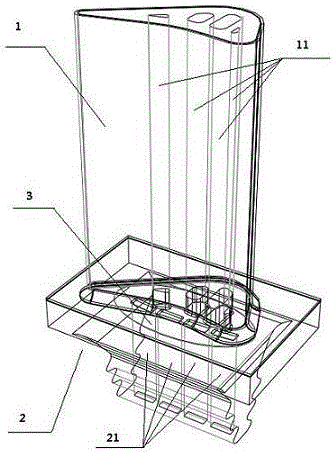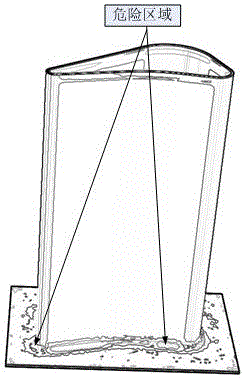A Mesh Division Method for Finite Element Model of Turbine Blade Thermal Barrier Coating
A technology of mesh division and thermal barrier coating, which is applied in special data processing applications, instruments, electrical digital data processing, etc. problems, to achieve the effect of convenient data extraction and analysis, avoiding software compatibility problems, and simple and feasible methods
- Summary
- Abstract
- Description
- Claims
- Application Information
AI Technical Summary
Problems solved by technology
Method used
Image
Examples
Embodiment 1
[0051] Select the single turbine blade model that has been established as the implementation object, and use the finite element software ABAQUS to establish the finite element model, mainly to carry out its finite element simulation under thermal cycle load.
[0052] For the sake of convenience and simplification, the present invention makes the following assumptions: 1) The material of each layer of TBCs is isotropic; 2) The thickness of each layer of TBCs is uniform; 3) The ideal elastic-plastic model is adopted; 4) The creep of each layer is a time-hardening model.
[0053] Firstly, the finite element model of the turbine blade thermal barrier coating is established, and the steps are as follows:
[0054] 1. Construction of geometric model of turbine blade without cooling channel
[0055] (1) Establishment of the geometric model of the blade body
[0056] (1) The establishment of the geometric model in the early stage
[0057] In the geometric model, the thermal barrier c...
Embodiment 2
[0132] In order to simplify, the second embodiment makes the following assumptions: 1) the materials of each layer of coating, base and tenon are uniform and all isotropic; 2) the thickness of each layer of coating is uniform; 3) the tenon is simplified as a cuboid; model, and only the high temperature creep of the TBC layer is considered.
[0133] The finite element model of the thermal barrier coating of the turbine blade is established according to the following steps:
[0134] (1) The establishment of the geometric model in the early stage
[0135] In the model, the ceramic layer is represented by TBC, and the thickness is h c ; The oxide layer is represented by TGO, the thickness is h t ; The transition layer is denoted by BC, and its thickness is h b ; The airfoil base of the turbine blade is denoted by SUB, and the thickness is h s ; The base thickness of the tenon of the turbine blade is h d , where h c =0.40mm, h t = 0.10mm, h b = 0.20mm, h s = 1.80mm, h d =...
PUM
 Login to View More
Login to View More Abstract
Description
Claims
Application Information
 Login to View More
Login to View More - R&D
- Intellectual Property
- Life Sciences
- Materials
- Tech Scout
- Unparalleled Data Quality
- Higher Quality Content
- 60% Fewer Hallucinations
Browse by: Latest US Patents, China's latest patents, Technical Efficacy Thesaurus, Application Domain, Technology Topic, Popular Technical Reports.
© 2025 PatSnap. All rights reserved.Legal|Privacy policy|Modern Slavery Act Transparency Statement|Sitemap|About US| Contact US: help@patsnap.com



